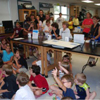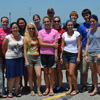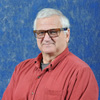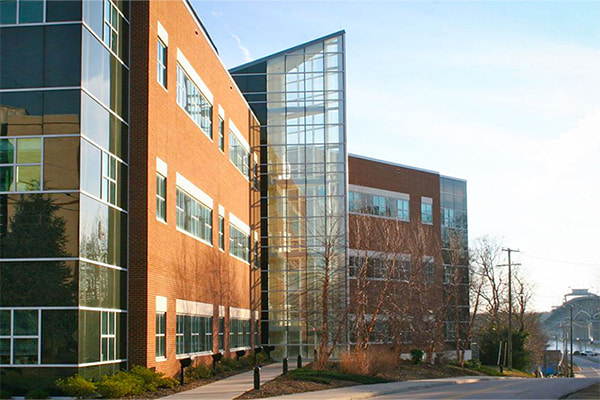
2013 was another great year for the students, staff, and faculty at the Virginia Institute of Marine Science. Take look back at the year's top stories.

2013 was another great year for the students, staff, and faculty at the Virginia Institute of Marine Science. Take look back at the year's top stories.

The Virginia Institute of Marine Science recently recognized graduate student Mark Stratton as the recipient of the SunTrust Mid-Atlantic Foundation Fellowship for 2013-2014.

Left to themselves, coastal wetlands can withstand rapid rates of sea-level rise. But humans could be sabotaging some of the wetlands’ best defenses, according to a Nature review paper by VIMS researcher Matt Kirwan and Pat Megonigal of the Smithsonian Environmental Research Center.

W&M alumna Dr. Katherine Potter, who did her honors thesis with Professor Rob Hale at VIMS in 2004, is the principal investigator of the Rwanda Climate Observatory.

Dr. Louis Daniel, Director of the North Carolina Division of Marine Fisheries and a graduate of the Virginia Institute of Marine Science, has been chosen as the new chairman of the Atlantic States Marine Fisheries Commission.

VIMS professor Robert “JJ” Orth collaborates with Australian colleagues on a 3-year project to adapt terrestrial models of seed-based restoration to seagrasses.

New VIMS faculty member Matt Kirwan gained his interest in coastal wetlands the hard way—through years of muskrat trapping in the marshes of the Eastern Shore.

Marine educators from Delaware to North Carolina traveled to the Virginia Institute of Marine Science last week for the Mid-Atlantic Marine Education Association’s annual conference.

The Atlantic States Marine Fisheries Commission recognizes VIMS researcher Jim Gartland for his outstanding contributions to the field of fisheries science.

Dr. Carl Friedrichs is recognized for his interdisciplinary achievements in research and teaching in the field of coastal hydrodynamics and sediment dynamics.

VIMS Ph.D. student Itchika Sivaipram carves the winning entry in the 2013 VIMS "Pumpkano" Contest.

VIMS professor Deborah Steinberg leads crowd on enthusiastic voyage From Plankton to Planet during evening presentation at Kimball Theater.

Research by Dr. Chris Hein reveals how shorelines shift in response to natural and human-driven changes in sea level, sediment supply, and coastal storms.

The Virginia Institute of Marine Science recently celebrated the graduation of four emerging professionals needed to advance Chesapeake Bay’s rapidly growing oyster-farming industry.

Dr. Bijoy Nandan chooses VIMS as host institution for Fulbright-Nehru Visiting Lecturer Fellowship.

VIMS survey records average number of young-of-year stripers; scientists say rebound will help stabilize rockfish population after last year's Baywide low recruitment.

The Virginia Institute of Marine Science opened its doors last week for an esteemed group of Virginia’s leaders during one of their stops in the LEAD VIRGINIA 2013 Alumni Conference.

The Virginia Institute of Marine Science’s Eastern Shore Laboratory (ESL) drew a large and enthusiastic crowd to its campus in Wachapreague for their first Marine Science Day open house on September 28th.

Study suggests fewer field observations could provide a more accurate and efficient means to measure the long-term progress of Bay restoration efforts.

Support from EVB and Gloucester County will allow Revolutionary War artifacts recovered from the VIMS campus to be shared with the public.

Professor Deborah Steinberg will share the mysteries of zooplankton during the Fall 2013 Tack Faculty Lecture Series on October 29 at the Kimball Theater in Williamsburg.

In-house competition recognizes the most engaging images taken by VIMS faculty, students, and staff in the field and lab.

Assistant Professor Donglai Gong deploys his new ocean glider as part of a coordinated effort to simultaneously observe the coastal waters of the entire eastern seaboard.

VIMS PERFECT/GK12 Fellow Jami Ivory brings fish anatomy out of a textbook and into the real world during a 7th-grade life science class at Booker T. Washington Middle School in Newport News.

VIMS Ph.D. students Katie May Laumann and Julia Moriarty were independently selected by the National Science Foundation for the prestigious East Asia and Pacific Summer Institute for U.S. Graduate Students.

Tropical coral reefs have been long thought to be the areas of greatest marine biodiversity, but a new trait-based study of reef fishes reveals new hotspots of biodiversity.

Participants in a conference organized by the Virginia Coastal Policy Clinic cite document as blueprint for state response to coastal flooding issues.

VIMS study is first to link quality of seagrass habitat to density of juvenile blue crabs over large areas.

VIMS researchers continue to monitor a large bloom of Alexandrium monilatum in the lower York River and blooms of Cochlodinium and other species throughout the lower Bay.

Professor Roger Mann and alum A.J. Erskine will each serve another three-year term on the Commonwealth’s Aquaculture Advisory Board.

The Virginia Institute of Marine Science welcomes 19 new graduate students this week, bringing total enrollment in the College of William & Mary’s School of Marine Science at VIMS to 91 students.

Public officials, attorneys, scientists, and concerned citizens will gather on September 13 at William & Mary for a day-long conference on "Adaptive Planning for Flooding and Coastal Change in Virginia: Legal and Policy Issues for Government."

Andrew Wargo studies the ecology of parasites, viruses, and other pathogens, and the mutual evolution between these organisms and their hosts.

Algal blooms have appeared in Chesapeake Bay several weeks later this year than last, likely due to this summer’s cooler temperatures.

Researchers with the National Marine Fisheries Service have determined that a cetacean morbillivirus is causing unusually large numbers of dead dolphins to wash up on mid-Atlantic beaches.

Students work with faculty mentors on an in-depth research project to gain experience in the field and laboratory.

Sediment coring lab donates aluminum piping to local welder for creation of goals posts for the Gloucester Youth Football League.

Five high-school and college students from Virginia’s Eastern Shore had the opportunity to pursue marine science research this summer at VIMS' Eastern Shore Laboratory in Wachapreague.

Local children swam, splashed, fished, and crabbed their way to becoming stewards of Chesapeake Bay during a series of five week-long summer day-camps offered by VIMS.

Guided self-assessment and on-site consultation with a museum professional will help VIMS staff better serve both the scientific community and citizens of Virginia and the Chesapeake Bay watershed.

Summer interns from the Virginia offices of Senator Mark Warner and representatives J. Randy Forbes and Scott Rigell visit VIMS to learn more about the Institute and its efforts to protect and restore Chesapeake Bay.

VIMS alumna Bethany Smith recently set sail with the 2013 Nautilus Exploration Program on a 8-day expedition to the Gulf of Mexico and Caribbean Sea.

VIMS alumnus Michael Wagner, Assistant Professor at Michigan State University, is researching and developing methods to control one of the most destructive invasive species in the Great Lakes—the sea lamprey.

Representative joins VIMS scientists for visit to South Bay, epicenter of a 16-year collaborative effort to restore eelgrass, oysters, and bay scallops to the seaside bays of Virginia’s Eastern Shore.

Ten-year study provides the first quantitative evidence on a bay-wide scale that oxygen-poor waters impact the distribution and abundance of fishes that live and feed near the Bay bottom.

Professor Jim Perry of the Virginia Institute of Marine Science, College of William & Mary, has been elected President of the Society of Wetland Scientists (SWS).

A dozen students visit VIMS for an intensive summer course on the microscopic world of fish larvae.

VIMS scientists answer questions about sustainable use of marine resources during visit arranged by State Dept.'s Washington Foreign Press Center.

Professor Emmett Duffy will lead new long-term initiative to study coastal marine biodiversity and ecosystems around the globe.

VIMS Professor Linda Schaffner has been selected to participate in an intensive two-week professional-development program dedicated to advancing women leaders in higher education administration.

A team of European entrepreneurs and scientists aim to bring lessons learned from seagrass restoration in Virginia’s seaside bays to the coastal waters of Scandinavia.

A grant to a VIMS research team will help them develop and test a biodegradable replacement for one of the two main sources of microplastic—the “microbeads” found in scores of household products.

New research vessel will replace the R/V Fish Hawk as the primary platform for VIMS’ juvenile-fish abundance surveys.

The Virginia Institute of Marine Science recently welcomed the fifth group of interns to its six-month Oyster Aquaculture Training Program (OAT) to learn the skills needed to enter Chesapeake Bay’s rapidly growing oyster-farming industry.

Virginia Coastal Policy Clinic gives students opportunity to immerse themselves in practical law and policy issues while addressing issues facing Virginia's coastal communities.

VIMS welcomes a large and enthusiastic crowd of more than 2,000 visitors to its 11th-annual open house in Gloucester Point.

Recent VIMS Ph.D. recipient Dr. Sam Lake wins the 2013 Thatcher Prize for Excellence in Graduate and Professional Study during William & Mary’s commencement ceremony on May 12th.

VIMS Professor Roger Mann and colleagues explore the ability of oyster reefs to buffer the increasing acidity of ocean waters.

A study led by VIMS researcher Lisa Kellogg shows that a restored oyster reef can remove up to 10 times more nitrogen from Chesapeake Bay waters than an unrestored area nearby.

VIMS-led research reveals that organic carbon in runoff from urbanized landscapes is more likely to persist as it is carried downstream, thus contributing to low-oxygen “dead zones” in coastal waters.

Winter dredge survey of the bay-wide blue crab population shows a mixed bag of good and not-so-good news that may result in a slight tightening of commercial harvest restrictions.

VIMS chooses Lauren Gregg as the Grand Prize winner in its annual Marine Science Day artwork contest.

Results from the VIMS-led seagrass monitoring program show that underwater grasses in Chesapeake Bay and its tidal rivers declined 24% between 2011 and 2012, approaching lows last reported in 1986.

VIMS Professor J. Emmett Duffy and colleagues call for establishment of a comprehensive network to monitor marine biodiversity, a key bellwether of ocean and human health.

A study that began as a class project among graduate students at the Virginia Institute of Marine Science is now a peer–reviewed research article in Ecology, the flagship journal of the Ecological Society of America.

VIMS Professors of Marine Science John Graves and Robert (J.J.) Orth have been selected as recipients of 2013 Plumeri Awards for Faculty Excellence at the College of William & Mary.

New collaborative study between VIMS and USGS credits tiny crustacean "grazers" for maintaining health of seagrass meadows.

Thomas Murray, Associate Director for Advisory Services at VIMS, was presented with a Recreational Boating Access Award from the Boat Owners Association of the United States (BoatUS).

Marine Recreation Specialist Susanna Musick of VIMS has been selected by the Virginia Beach Angler’s Club as the recipient of the prestigious Dr. James C. Wright Conservation Honorary Award.

Dr. Mark Luckenbach will serve as the principal administrative officer for VIMS’ research and advisory service activities, which are mandated in more than 30 different sections of the Virginia Code.

A new 5-year grant from the National Science Foundation will jumpstart an industry-university partnership to promote sustainable fisheries throughout the Mid-Atlantic and Gulf coast region.

Gloucester gallery showcases the talents of local artists who submitted entries to this year's Marine Science Day oyster artwork contest.

Seventh graders at Queens Lake Middle School in Williamsburg recently took learning to another level with the use of Twitter.

Program organizers acknowledge volunteers for tagging more than 31,600 fish in 2012, a new record.

Reviewers note that new book "brings each species to life" and is an “indispensable resource for both anglers and students.”

Students, faculty, and staff celebrate the mathematical and gastronomical versions of pi(e) with a community-building and fund-raising event.

Professors Walker Smith and Deborah Steinberg will testify in a March 22 simulation that is designed to determine how legislative hearings can best use modern technology to enhance success, efficiency, and transparency.

Professor Steve Kuehl and team analyze sediment cores for long-term record of extreme events and changing Arctic climate.

Report recommends steps for managing the use of nitrogen and phosphorous in a world where there are too many of these and other nutrients in some areas and too few in others.

The family of the late VIMS Professor of Marine Science Rebecca Dickhut has provided the Virginia Institute of Marine Science with a generous gift of $300,000 to establish The Rebecca Dickhut Endowment for Support of Students and Young Early Career Scientists.

Virginia Beach high school takes top honors—for a record 6th-straight time—at the 16th annual regional Ocean Science Bowl.

Cook-off determines VIMS' tastiest chili or cornbread recipes.

Physical oceanographer Donglai Gong uses gliders and moorings to study the movement and properties of coastal waters in the mid-Atlantic and Arctic.

Research and monitoring at VIMS provide data used to compile Chesapeake Bay Program's annual report on Bay health and the status of restoration efforts.

Students, staff, and faculty from VIMS took part in Virginia Sea Grant’s 4th Annual Project Participants’ Symposium by sharing their efforts to protect and restore coastal Virginia.

In-kind gift of scientific equipment will support studies and monitoring of water quality and ecosystem health in Chesapeake Bay and the coastal ocean.

VIMS professor honored by the State Council of Higher Education for Virginia for excellence in teaching, research, knowledge integration, and public service.

VIMS' 2nd Annual International Potluck Dinner showcased the cultural diversity of the graduate students in W&M's School of Marine Science and featured dishes from around the world.

VIMS Ph.D. student and GK12 Fellow Christina Pondell leads students on a scavenger hunt that offers insight into her research and an opportunity to discover new things about their local environment.

Professors Robert “JJ” Orth and Ken Moore are funded to work with Danish colleagues in an effort to develop innovative techniques and tools for eelgrass restoration.

Report provides detailed plan for how the Commonwealth can best respond to coastal flooding.